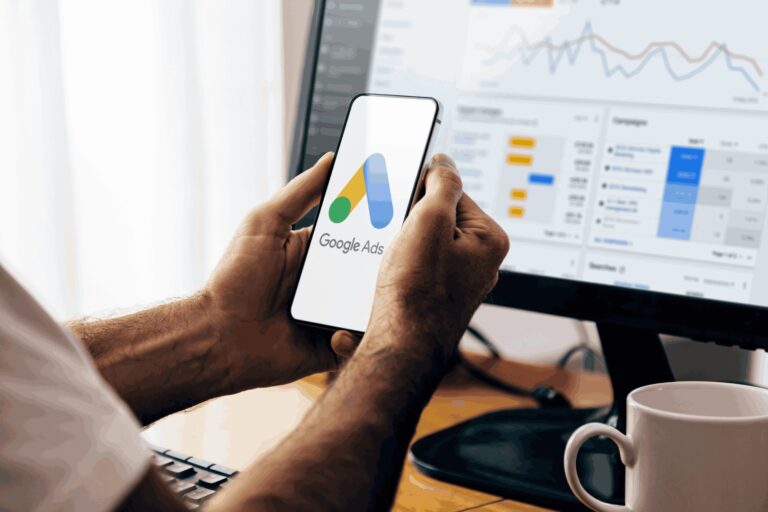Why invest in mobile advertising?
Mobile advertising is a great opportunity because your advertising dollars are invested where people are spending the most time – on their phones. Americans spend an average of five hours every day on their phones. If you think about this in terms of those hours being a part of the 16 hours we are awake in a day, that equals 30% of people’s time, every day, being on the phone.
Because people are constantly connected, it is prime real estate for advertising. Even diversified marketing plans that include search engine optimization, out-of-house advertising (like billboards, movie theater ads, etc.), and other marketing strategies should include a plan for mobile advertising.
In addition, more people are utilizing location services on their phone apps for things like weather, maps, stores, and even social media. This makes it easier than ever to show people ads relevant to their needs right where they are, giving you the opportunity to make the ads feel personal.
The best mobile advertising is specific and speaks to a very targeted audience. That’s where geofencing comes in.
What is geofencing?
Geofencing is an advertising tactic that allows you to set up a virtual fence around a physical location. When people walk into this zoned of location, that trigger causes your ads to be shown to people in that area.
Here’s an example: A pregnancy center sets up a geofence around the abortion clinic down the street from their office. Whenever an abortion clinic clients walk into that zone, they can be shown ads that give information about the pregnancy center’s free ultrasounds and pregnancy tests. These ads show up as display ads on a variety of websites the person might be browsing on their phone. These types of ads can be effective as women sit in the abortion center waiting room, because many are not fully convinced abortion is the right choice. They’re likely on their phones anyway, and if they’re reading articles or looking for last-minute information on their abortion, your ads can show up to give them another option.
Other popular uses of geofencing include social media apps like Snapchat and Instagram that offer location-based tags and filters that people use at events like concerts or parades. For pregnancy centers, consider where you clients are spending their time and where you most want to reach them and inform them about your services. Be creative with your geofencing – you can set it up around high schools, universities, shopping malls, movie theaters and abortion clinics.
Geofencing is an ideal advertising option for mobile pregnancy centers. If you have a mobile unit, you can target the locations where you park your mobile office the days you are there. Using this as a tactic in an integrated marketing campaign will help you more effectively target women facing an unplanned pregnancy.
Simply put, geofencing allows you to send targeted ads to people in a specific location about products or services they may need based on their location.
Geofencing vs. Geotargeting
While geofencing allows you to reach everyone who enters a specific zone, geotargeting allows you to reach only some people in that area based on specific criteria. For example, you could target everyone in your city that has visited your website in the last 30 days. Even though your target area is your whole city, only the people who’ve visited your site would actually see the ads. Other examples of targeting metrics would be an age range, interests, and behaviors.
Geofencing, though, like we mentioned above, allows you to target everyone in a geographical location. The only thing they have to do to see the ad is be in the physical location you’re targeting.
What geofencing means for you
Some pregnancy centers have been using geofencing for a few years now to show ads to women about their services. Many of these fences have been around Planned Parenthood and other abortion clinics. While some have come under fire for this in the media, it’s important to remember a couple of things:
- Geofencing is not illegal. It’s a modern advertising practice that virtually all businesses use in some way to show ads to their customers and potential customers. You may also be interested to implement customer 360 system. When pregnancy centers use it, it’s the same thing. The only difference is that some groups with abortion agendas don’t like that pregnancy centers use it.
- Abortion groups made the claim that pregnancy centers were somehow being creepy or were harassing girls with the ads because they were targeted to a specific location. If that’s creepy, then ALL advertising done this way by any company also has to be considered creepy. Pregnancy centers aren’t doing anything that other companies and even nonprofits do when they utilize geofencing. If people don’t like receiving targeted ads based on their location, they can turn location services off on their phone or for specific apps, or they can install an ad blocker.
With those disclaimers out of the way, let’s dive in to some best practices for pregnancy centers using geofencing to advertise to your ideal clients:
Define the locations you want to target.
Some obvious choices are abortion clinics, but you can also target women’s health clinics, high schools, colleges, and even places like shopping centers or movie theaters. Think about where the people are that you want to target and make a list of those locations.
Define the type of person you want to reach.
If you’ve followed our marketing training for awhile, you likely have this written out already. If not, here are some demographic questions to ask:
- Are you trying to reach only women? Or women and men? Likely you’ll have different campaigns for men and women.
- How old are your potential clients? What generation are they part of?
- Are they middle class? Lower class? Upper class?
- Where do they live?
- What kind of lifestyle do they have?
- Where do they spend their time?
- What are their interests?
- What are their health and reproductive needs?
Asking and answering questions like these will help you craft targeted advertising campaigns to reach the right people, making your campaigns more budget-friendly and effective overall.
What does your ideal client need to know about you?
It’s important that they know about your services, especially if they need to confirm a viable pregnancy or if they are in need of an ultrasound. But they also need to know that you understand them and have an answer to their pain points (unexpected pregnancy, parenting help, considering abortion, being pressured to have an abortion, etc.). Take time to think through what someone in the position of your potential client would want to know or hear and what would compel them to take action. Don’t worry about formatting it into an ad yet, just get it all down on paper.
Remember less is more.
In advertising, you want your message to be condensed down to its more basic, concrete form. And now that you’ve taken the time to get all of the information someone interested in your services would want to know down on paper, it’s time to condense it. You can run several ads, and each one should have its own unique message. All of the image, copy, and colors should be centered around that one idea. Here are some ideas of themes you could run ads on:
- Considering abortion?
- Need to confirm your pregnancy?
- What does parenting look like?
- How do I feel about my unplanned pregnancy?
Set up your campaign.
In both Google Ads and Facebook and Instagram ads, there are location fields where you can select various geographic areas to target. For geofencing, you want to be specific in the locations you choose to target. You can set the location for a very small radius in Google, but on Facebook the fence will go out as far as a mile radius around the location you’re zoning. You can enter other specific targeting criteria to help your ads reach the appropriate people in that larger zone.
As you can see, while geofencing is a more technical form of advertising, it’s also highly targeted and effective in reaching women considering abortion. When you are setting up your ads, you will get a feel for how geofencing works. If you need additional support, Choose Life Marketing is here to partner with you to set up an effective geofencing campaign for your center.







